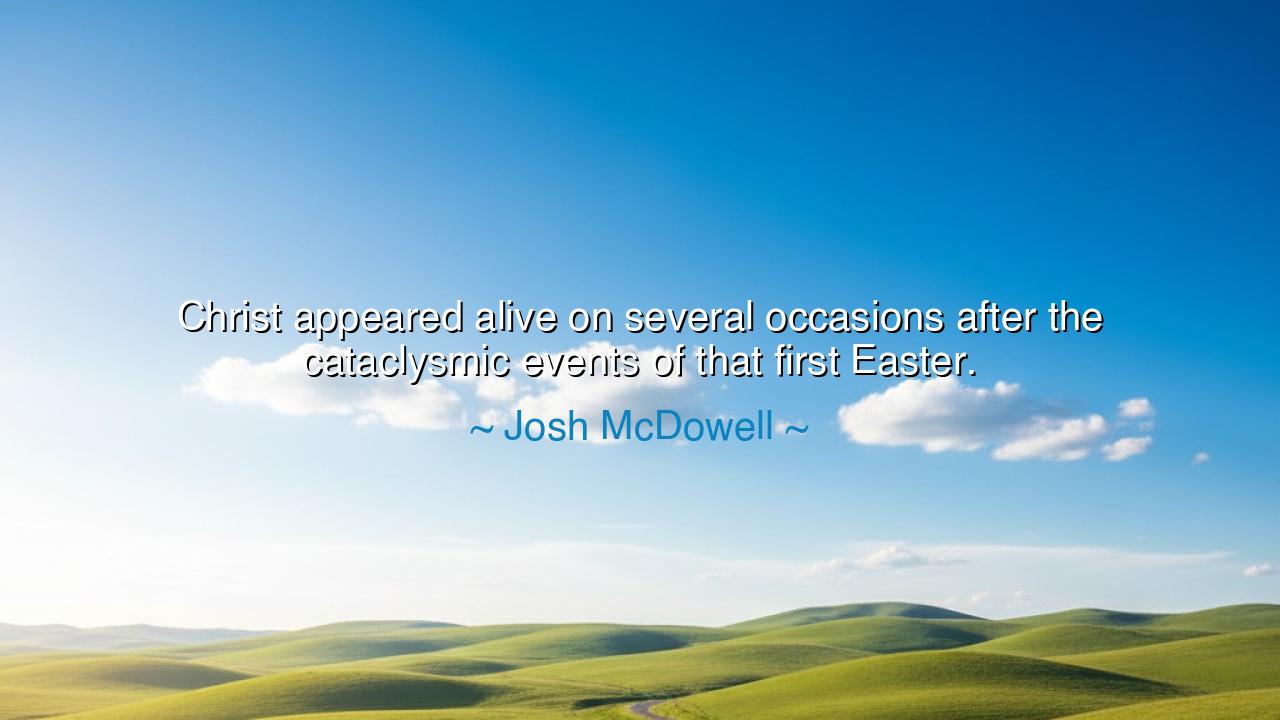
Christ appeared alive on several occasions after the cataclysmic
Christ appeared alive on several occasions after the cataclysmic events of that first Easter.






The words of Josh McDowell — “Christ appeared alive on several occasions after the cataclysmic events of that first Easter” — speak with the resonance of faith rekindled in the ashes of despair. They recall that moment when the world stood trembling between death and resurrection, between hopelessness and glory. In these words lies not merely a statement of history, but the pulse of eternal hope: that the divine, once thought conquered by the grave, rose to walk among the living once more. McDowell’s reflection, grounded in both faith and reason, points to the heart of Christianity itself — that life triumphed where death seemed absolute, and that the risen Christ did not ascend at once into mystery, but lingered among His followers to prove love’s victory with His presence.
In the style of the ancients, we may say: “What was dead now lives, and what was lost now endures forever.” McDowell, a modern apologist and defender of faith, sought to remind his generation that the resurrection was not a mere fable of the heart but an event woven into the fabric of reality. His use of the word “cataclysmic” captures the cosmic scale of that first Easter — the earthquake that split not only the earth but the history of humankind. The crucifixion was the breaking of the world; the resurrection, its rebirth. When Christ appeared again, He did not come as a ghost or illusion, but as the living testimony that hope is stronger than despair, truth greater than fear, and love unconquerable even by death itself.
The origin of this quote lies in McDowell’s lifelong mission to defend the credibility of the resurrection, as expressed in his seminal works such as Evidence That Demands a Verdict and The Resurrection Factor. Once a skeptic, McDowell set out to disprove Christianity but found, through research and reason, that the testimony of the early disciples was unwavering: they had seen, touched, and walked beside the risen Christ. He concluded that no deception could explain such courage, for men do not willingly die for a lie. Thus, his statement that Christ “appeared alive on several occasions” is not poetic exaggeration, but an affirmation of historical faith — a bridge between reason and revelation, intellect and spirit.
Consider, as a living example, the story of Thomas, the apostle who doubted. His heart, like many, was shattered by the cross. When told that Christ had risen, he demanded proof — the touch of flesh, the sight of wounds. And Christ, in infinite mercy, granted it. He stood before Thomas and said, “Reach out your hand and see.” In that moment, the skeptic’s reason met the believer’s revelation. This encounter embodies McDowell’s point — that the risen Christ appeared not as rumor or myth, but as reality breaking through disbelief. The transformation of Thomas — from doubter to missionary who carried the gospel as far as India — stands as eternal witness to the truth of that first Easter.
McDowell’s phrase “after the cataclysmic events” also carries deeper meaning: that resurrection follows ruin, that divine renewal often comes only after devastation. In every age, humanity relives this pattern. Wars destroy nations, yet peace rises from the ruins. Hearts are broken by grief, yet love returns to heal. The story of Christ’s appearances is not confined to Scripture — it is reenacted whenever light follows darkness, whenever a soul once crushed by sorrow dares to hope again. Thus, the resurrection is not a relic of the past; it is the living rhythm of redemption pulsing through time itself.
Even the earliest believers bore witness to this truth with their lives. The apostles, once fearful and scattered, became bold as lions after these encounters. Peter, who had denied his Master, preached before thousands. Mary Magdalene, who wept at the tomb, became the first herald of joy. Their courage was the proof of encounter — for only those who have seen the risen Christ can bear suffering with serenity and face death with peace. As McDowell observed, the resurrection turned weak men into witnesses and grief into glory.
Let this teaching, then, pass to every heart that hears it: despair is never final. The “cataclysmic events” of our own lives — betrayal, loss, failure — are not the end, but the beginning of transformation. The same power that raised Christ from the tomb still whispers to the weary soul: Rise again. When the world seems shattered beyond repair, remember that even the first Easter began in darkness and ended in dawn.
So hold fast to McDowell’s truth: Christ appeared alive, and so shall life always reappear where love endures. Seek not merely the memory of that ancient miracle, but its presence in your own journey. For every morning that follows a night of tears, every forgiveness that blooms from bitterness, every courage that rises from fear — these too are the appearances of the Living Christ, walking still among those who believe.






AAdministratorAdministrator
Welcome, honored guests. Please leave a comment, we will respond soon